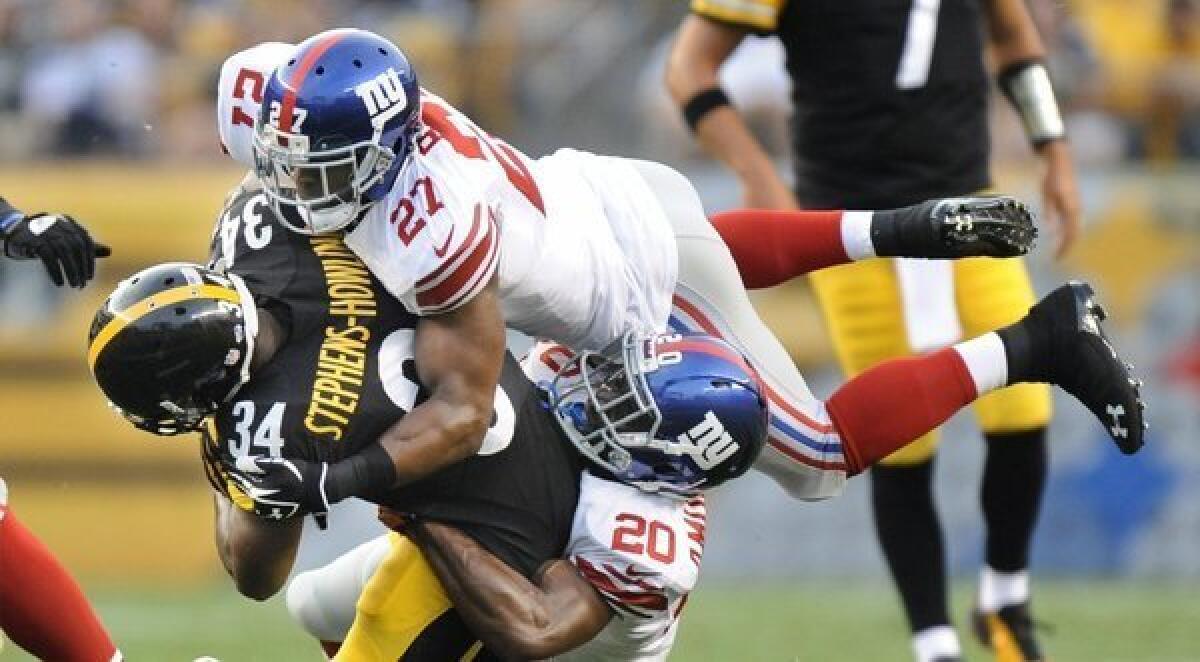The truth about football

- Share via
Football periodically faces extinction, but never has the game been enveloped in a crisis as odd as the current one. Just when the game plays safer than at any time in its 144-year history, its critics threaten to make the game history. Sportswriter Frank Deford calls football “barbarous.” Author Malcolm Gladwell labels it a “dumb … 19th century game.” But it’s that characterization that appears backward to anyone paying attention.
In 1905, when President Theodore Roosevelt intervened to help make the game he loved safer, more athletes died from on-field collisions on a single Saturday afternoon (three) than died from hits during all of the 2012 season (two). In 1968, a year of assassinations and bombings at home and peak casualties in the Vietnam War, football meshed with the violent times: An all-time high of 36 players were lost to collision deaths at all levels of competition. The rough sport, which could boast just two seasons of single-digit contact deaths between 1931 and 1977, has since 1977 experienced just one season of double-digit collision deaths — in 1986, the birth year of today’s average NFL player.
The dramatic reduction in fatalities should have caused football’s boo-birds to cheer, or at least chirp. Relative to its past and the present of other pastimes, football looks quite good. For instance, California suffered seven times as many collision deaths from skateboarding last year as the entire United States did from football.
Instead of putting football safety into perspective, the sport’s critics have shifted the conversation to chronic traumatic encephalopathy, or CTE, a degenerative brain disease found in a number of deceased football players, including Hall of Famers John Mackey and Mike Webster.
Unlike fatality numbers, generalizations regarding CTE are just that. The absence of a randomized study on CTE leaves football’s critics making sweeping assertions about the sport, though science can’t yet pinpoint the prevalence or even the cause of the condition. It’s irresponsible enough that pundits extrapolate autopsy findings from a few former pros to the entire NFL, but projecting the damage endured by a tiny fraction of athletes who toiled for years at elite levels onto youngsters who will never play beyond Pop Warner or high school competition goes beyond reckless.
In April, five scientists writing in the British Journal of Sports Medicine cautioned against such “causal assumptions” regarding contact sports and CTE because a “cause-and-effect relationship remains to be shown scientifically.”
All the while, in measurable areas, football progresses. In the National Football League, concussions dropped from 270 in 2010 to 266 in 2011 to 170 in 2012. A study published last year by federal researchers of pension-vested NFL retirees who played between 1959 and 1988 showed that just 10% of the group had died, compared with the expected rate of 18%. In other words, Hall of Famer Art Donovan, that burly bard of football folk tales who passed away at 88 this month, wasn’t much of an outlier, at least when it came to his life span. The National Institute for Occupational Safety and Health concluded that NFL retirees experience “significantly decreased” mortality relative to their peers in the U.S. population.
The same study, which the NFL Players Assn. petitioned the institute to conduct, also looked at suicide. Given the speculation linking CTE with the suicides of several high-profile players, the scientists’ findings were stunning. The study found a suicide rate for the retired athletes significantly below the expected rate.
So the facts about football dangers improve even if the perception doesn’t. In the end, longer lives and fewer deaths should offer a valuable lesson to football’s crusading abolitionists, and to its rigid purists. The former should grasp that football no longer poses the risks it once did. The latter should concede that reform is the reason.
Football is a sport of roughness and change. When the game gets too rough, as it had when Roosevelt got involved more than a century ago, change inevitably follows. The elimination of pre-snap forward motion (toward the scrimmage line) for running backs, the establishment of a neutral zone between offense and defense, and the introduction of the forward pass resulted from that deadly 1905 season. In the era following the grim 1968 season, spearing penalties forbidding head-first hits, and the introduction of industry standards that ushered in more-protective helmets, saved lives and made a fun sport safer.
Purists who protest change really don’t understand the sport they love. While baseball and soccer have essentially stayed the same since the 19th century, football has morphed from a collegiate kicking sport to a grinding ground game to a spectacle of aerial acrobatics. Those changes didn’t destroy the game, and surely the new rules allowing the NCAA to eject players for hits on defenseless receivers and allowing the NFL to penalize running backs who lower their heads into tacklers won’t destroy it either.
Football is anything but backward. It evolves. The game’s most zealous friends and foes might take a page out of football’s playbook and evolve too.
Daniel J. Flynn is the author of the about-to-be-published book, “The War on Football: Saving America’s Game.”
More to Read
A cure for the common opinion
Get thought-provoking perspectives with our weekly newsletter.
You may occasionally receive promotional content from the Los Angeles Times.










